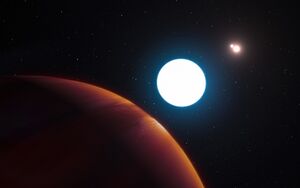
A trinary star system made up of 3 stars, the largest of which being the Class O1V blue giant star called Vlilt with 2 other stars in mutual orbits around each other. The other two stars are the smaller Class K1II main sequence star called Faussi and an even smaller Class M7V red dwarf star called Odanis. The Blue Giant is the only one observable with the naked eye from nearby deep space, the brightness drowning out its companions.
This system was surveyed by the STV Velvet Frog (SE-1929) under the command of Nauta Ciara Quinn in September of 2386. The ship reported irregular orbits for all 8 worlds and obtained more detailed cartographic surveys as well as samples from the 4the planet (a Class M world) for cataloguing.
- Location
- Adara Sector
2.8 ly from the Svyo Star System
3.9 ly from the Beeria Sector
Approximately 5-7 days travel at high warp from the Schatten Star System
Vlilt has such powerful gravity that it is slowly drawing stellar matter from both of its partners causing plasma streamers to spiral from Faussi and Odanis inward toward Vlilt at all times. There is a complex interaction between all three stars which is currently in a balanced state, with Faussi and Odanis in stable orbits not only with Vlilt but each other. It is theorized that all three stars may share stellar matter as each star moves around the others and that the gravitational interaction maintains the balance in size and orbit.
There are a total of 8 planets in the system. All 8 planets have irregular distorted orbits caused by the gravitational variances from the 3 stars.
Vlilt Prime
A Class B small dwarf planet with a very short orbital period of only 94 days, an incredibly hot world, incapable of supporting life. The surface is bombarded by continuous radiation from Vlilt with spikes when its orbit is closest to Faussi.
Vlilt 2
A Class A planet, about the same size as Earth, the surface is bombarded by constant ionizing radiation from Vlilt. The core is kept molten by tidal forces, which also cause continuous volcanic and tectonic instabilities. Eruptions of molten rock are common place, the atmosphere is thick and highly toxic. It has a single spheroid satellite dubbed Vlilt 2A, the satellite is about half the size of Earths moon and may be the result of a large scale impact during planetary formation.
Asteroid Belt
Possibly the result of a planetary collision, a belt of asteroids in a strangely curved orbit separated Vlilt 2 from Vlilt 3. The asteroids are composed of metallic ores, mostly dense radioactive metals.
Vlilt 3
A Class C planet, about the size of Mars. It has a pitted and cratered surface and no atmosphere. The core of the planet is molten, though tectonic and volcanic instability is low. The core is unusually dense carbon, similar to anthracite, along with other trace materials. There is an unusual amount of radioactive material found on the surface.
Vlilt 4
A Class M planet, about the size of Venus. It has a nitrogen-oxygen atmosphere, and has 3 smaller satellites. All 3 satellites are spheroid shaped with similar compositions to Vlilt 4, they are dubbed Vlilt 4A, B, and C. All three are roughly the same size, about the size of Jupiter's moon Io. They have an unusually strong magnetic field, which interacts with the planet's field to create a kind of radioactive shield. Visible light and heat pass through without issue but ionizing radiation flows around the magnetic bubble. Vlilt 4 has a thick atmosphere with an unusually dense ozone layer, which also helps to filter out ionizing radiation. Although this planet can support life, there is no known intelligent life on the planet, though there is abundant plant and animal life.
Vlilt 5
A Class K planet, about the size of Earth. It has no atmosphere and sports numerous craters. The core is similar to that of a Class M world with an unusually high amount of radioactive isotopes within. Liquid water and pockets of atmosphere may still exist within the planet's crust, evidence suggests the world might have once had surface water as well.
Vlilt 6
A Class J planet, about the size of Saturn. Composed of dense layers of hydrogen and helium with a core of liquid metallic hydrogen, this planet has a large array of natural satellites, most likely captured asteroids. They are designated as Vlilt 6A to 6R.
Vlilt 7
A Class J planet, about the size of Jupiter. Composed of dense layers of hydrogen and helium with a core of liquid metallic hydrogen, this planet has an impressive ring system composed of an interplanetary ice/rock/dust mix. There are only 4 natural satellites dubbed Vlilt 7A to 7D. Only Vlilt 7B is spheroid, the rest are likely captured asteroids. Vlilt 7B has an oxygen/nitrogen atmosphere, though too thin to support many life forms, some single and small multicellular life forms may be present.
Vlilt 8
A Class C planet, about half the size of Earth. It is in a very elongated orbit turning at an unusually slow rate. Devoid of an atmosphere it is pitted with craters and evidence of multiple large scale impacts on the surface. The core is composed of mostly basalt with some other trace elements present, though the curst has significant deposits of many precious metals.
Due to the unusually strong gravity of the blue giant Vlilt and the interaction of its sister worlds, the system is prone to strong gravitational eddies and currents. A highly energized solar wind is also present, mostly from Vlilt, with some contribution from Faussi. Ships entering this system may experience unexpected computer glitches if not properly shielded. Travel to the 1st planet or closer could also expose a starship or large amount of ionizing radiation.
Sensors need to be calibrated to the gravitational currents as well as the radiation profile in order to operate properly.